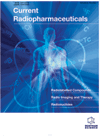- Home
- A-Z Publications
- Current Radiopharmaceuticals
- Previous Issues
- Volume 14, Issue 2, 2021
Current Radiopharmaceuticals - Volume 14, Issue 2, 2021
Volume 14, Issue 2, 2021
-
-
Challenges in the Correct Assessment of a Case of Aggressive Thyroid Carcinoma with Synchronous Breast Cancer: A Case Report and Review of the Literature of Essential Role of Radiopharmaceuticals
More LessAuthors: Andra Piciu, Alexandru Mester, George Rusu and Doina PiciuThyroid carcinoma represents a complex pathology that can still be considered a medical challenge, despite having a better prognosis and life expectancy than most other neoplasms; also the scenario of multiple malignancies involving thyroid cancer is nowadays a common reality. Materials and methods: We reviewed the literature regarding the aggressive presentation of synchronous thyroid and breast cancer. In t Read More
-
-
-
An Exposition of 11C and 18F Radiotracers Synthesis for PET Imaging
More LessAuthors: Priya Saxena, Tarique Mahmood, Manish Dixit, Sanjay Gambhir and Farogh AhsanThe development of new radiolabeled Positron emission tomography tracers has been extensively utilized to access the increasing diversity in the research process and to facilitate the development in research methodology, clinical usage of drug discovery and patient care. Recent advances in radiochemistry, as well as the latest techniques in automated radio-synthesizer, have encouraged and challenged the radiochemists to Read More
-
-
-
Direct incorporation of [18F] into Aliphatic Systems: A promising Mn-catalysed Labelling Technique for PET Imaging
More LessAuthors: Sara Cesarec, Jonathan A. Robson, Laurence S. Carroll, Eric O. Aboagye and Alan C. SpiveyBackground: One of the challenges in positron emission tomography (PET) is labelling complex aliphatic molecules. Objective: This study aimed to develop a method of metal-catalysed radiofluorination that is site-selective and works in moderate to good yields under facile conditions. Methods: Herein, we report on the optimisation of an aliphatic C-H to C-18F bond transformation catalysed by a Mn(porphyrin) complex. Results: T Read More
-
-
-
Administered Pediatric Radiopharmaceutical Doses at a Tertiary Hospital in South Africa: A Comparison with Corresponding Activities Based on North American Consensus Guidelines and Administration of Radioactive Substances Advisory Committee Guidelines
More LessBackground: Diagnostic nuclear medicine reveals physiological processes in vivo, facilitating early detection of disease prior to anatomical changes. However, in pediatric studies, the selection of appropriate dosing guidelines is challenging. Administration of Radioactive Substances Advisory Committee (ARSAC) and North American Consensus (NAC) guidelines are extensively used. Objective: To determine appropriate pediatri Read More
-
-
-
Evaluation of Left Ventricular Volumes and Ejection Fraction from Gated Myocardial Perfusion SPECT Processed with “Myovation Evolution”: Comparison of Three Automated Software Packages using Cardiac Magnetic Resonance as Reference
More LessBackground : The development of resolution recovery (RR) algorithms has made it possible to preserve the good quality of cardiac images despite a reduced number of counts during study acquisition. Objective: Our purpose was to evaluate the performance of three different software packages in the quantification of left ventricular (LV) end-diastolic volume (EDV), end-systolic volume (ESV), and ejection fraction (EF) fro Read More
-
-
-
A Rapid and Specific HPLC Method to Determine Chemical and Radiochemical Purity of [68Ga]Ga-DOTA-Pentixafor (PET) Tracer: Development and Validation
More LessBackground: Due to its overexpression in a variety of tumor types, the chemokine receptor 4 (CXCR4) represents a highly relevant diagnostic and therapeutic target in nuclear oncology. Recently, [68Ga]Ga-DOTA-Pentixafor has emerged as an excellent imaging agent for positron emission tomography (PET) of CXCR4 expression in vivo. Preparation conditions may influence the quality and in vivo behaviour of this tracer and Read More
-
-
-
Analytical GC-FID Method for the Determination of Organic Solvents in Radiopharmaceuticals
More LessBackground: Organic solvents play an indispensable role in most of the radiopharmaceutical production stages. It is almost impossible to remove them entirely in the final formulation of the product. Objective: In this presented work, an analytical method by gas chromatography coupled with flame ionization detection (GC-FID) has been developed to determine organic solvents in radiopharmaceutical samples. The effect of inj Read More
-
-
-
Calcium Carbonate Microparticles as Carriers of 224Ra: Impact of Specific Activity in Mice with Intraperitoneal Ovarian Cancer
More LessBackground: Patients with advanced-stage ovarian cancer face a poor prognosis because of recurrent peritoneal cavity metastases following surgery and chemotherapy. Alpha-emitters may enable the efficient treatment of such disseminated diseases because of their short range and highly energetic radiation. Radium-224 is a candidate α-emitter due to its convenient 3.6-day half-life, with more than 90% of the decay Read More
-
-
-
Development of 186/188Re-Chitosan as an Effective Therapeutic Agent for Rheumatoid Arthritis
More LessBackground: Rheumatoid arthritis (RA) is an inflammatory chronic disease characterized by inflammation, pain, swelling and disability, and radiosynovectomy is one of the disease treatment lines. In this study, the possibility of providing rhenium-186/rhenium-188 chitosan radiopharmaceuticals, optimization of conditions for their production and bio-distribution are reported. Objective: In order to build perrh Read More
-
-
-
Gonioprobe, an Innovative Gamma-probe to Guide Parathyroid Radioguided Surgery: First Clinical Experiences with Navigator and Lock-ontarget Functions
More LessBackground: Radioguided surgery represents a validated technique for the detection and the excision of abnormal parathyroid glands responsible for primary hyperparathyroidism (PHPT). To date little attention has been paid as to how the characteristics of gamma-probes can influence surgical procedure and time, thus having an impact on postoperative morbidity, hospitalization and costs. Methods: We designed a new Read More
-
Volumes & issues
Most Read This Month
Article
content/journals/crp
Journal
10
5
false
en


